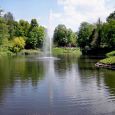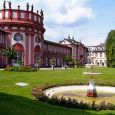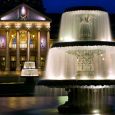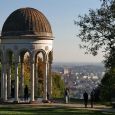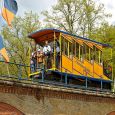Wiesbaden
Advertisement
By Air
The nearest airport is Frankfurt International Airport and discount airline flights are available at Frankfurt-Hahn Airport around an hour's drive to the southwest.
By Train
Wiesbaden's main railway station and several minor railway stops connect the town with Frankfurt, Darmstadt, Mainz, Limburg and Koblenz via Rüdesheim.Wiesbaden Hauptbahnhof is connected to the Cologne-Frankfurt high-speed rail line by a 13-kilometer branch line.Hamburg, München, Leipzig, Dresden, Stuttgart, Mannheim and Hanover are connected directly to Wiesbaden via long distance service of the Deutsche Bahn.More services to locations outside the immediate area connect through Mainz Hauptbahnhof or Frankfurt Airport long-distance station or Frankfurt Hauptbahnhof.Regional train and bus services are coordinated by the Rhein-Main-Verkehrsverbund.
By Bus
The city's public transportation service ESWE Verkehr connects all city districts to downtown by 45 bus lines in the daytime and 10 bus lines in the night.Five more bus lines, operated by the public transportation service of the city of Mainz, connects Wiesbaden's districts Kastel and Kostheim to Mainz downtown.
By Road
The A66, A671 and A643 autobahns directly service Wiesbaden, connecting to the nearby A3, A60 and A61.
The Palace Square
is situated in the center of the city, surrounded by several outstanding buildings. The ducal palace was begun under William, Duke of Nassau. Its foundations were laid in 1837 and it was completed in November 1841 (two years after William's death). For the twenty-six remaining years of ducal authority it was the residence of the ruling family. It later served as a secondary residence for the King of Prussia 1866 to 1918. It was later used as a headquarters for French and British occupying forces after World War I, then as a museum. Since 1945, the building has served as Landtag (parliamentary building) for the federal state of Hesse. The site of the palace had been that of a castle, probably from the early Middle Ages, around which the city had developed. While nothing is known of the former castle, remains of it were uncovered during excavations after World War II.
Kurhaus and Theater
The monumental Neo-Classical Kurhaus ("spa house") was built at the request of Kaiser Wilhelm II between 1904 and 1907. Its famous Spielbank (casino) is again in operation.In front of the Kurhaus is a lawn known as the Bowling Green. To one side of the Bowling Green is the Kurhaus Kolonnade. Built in 1827, the 129 meter structure is the longest hall in Europe supported by pillars. To the other side is the Theater Kolonnade, built in 1839. It is adjacent to the Hessian State Theater, built between 1892 and 1894.
St. Bonifatius Church
the first church for the Catholic community after the Reformation, was built from 1845 until 1849 by Philipp Hoffmann in Gothic Revival style and dedicated to Saint Boniface.
Museum Wiesbaden
is a museum in the Hessian capital Wiesbaden, Germany. Besides the museums in Kassel and Darmstadt, it is one of the three Hessian state museums. The museum comprises an art collection, a natural history collection and a collection of Nassauian antiquities.
St. Elizabeth's Church
The Russian Orthodox Church of Saint Elizabeth was built on the Neroberg from 1847 to 1855 by Duke Adolf of Nassau on the occasion of the early death of his wife Elizabeth Mikhailovna, who died in childbirth. The architect was Philipp Hoffmann.
Information not available


